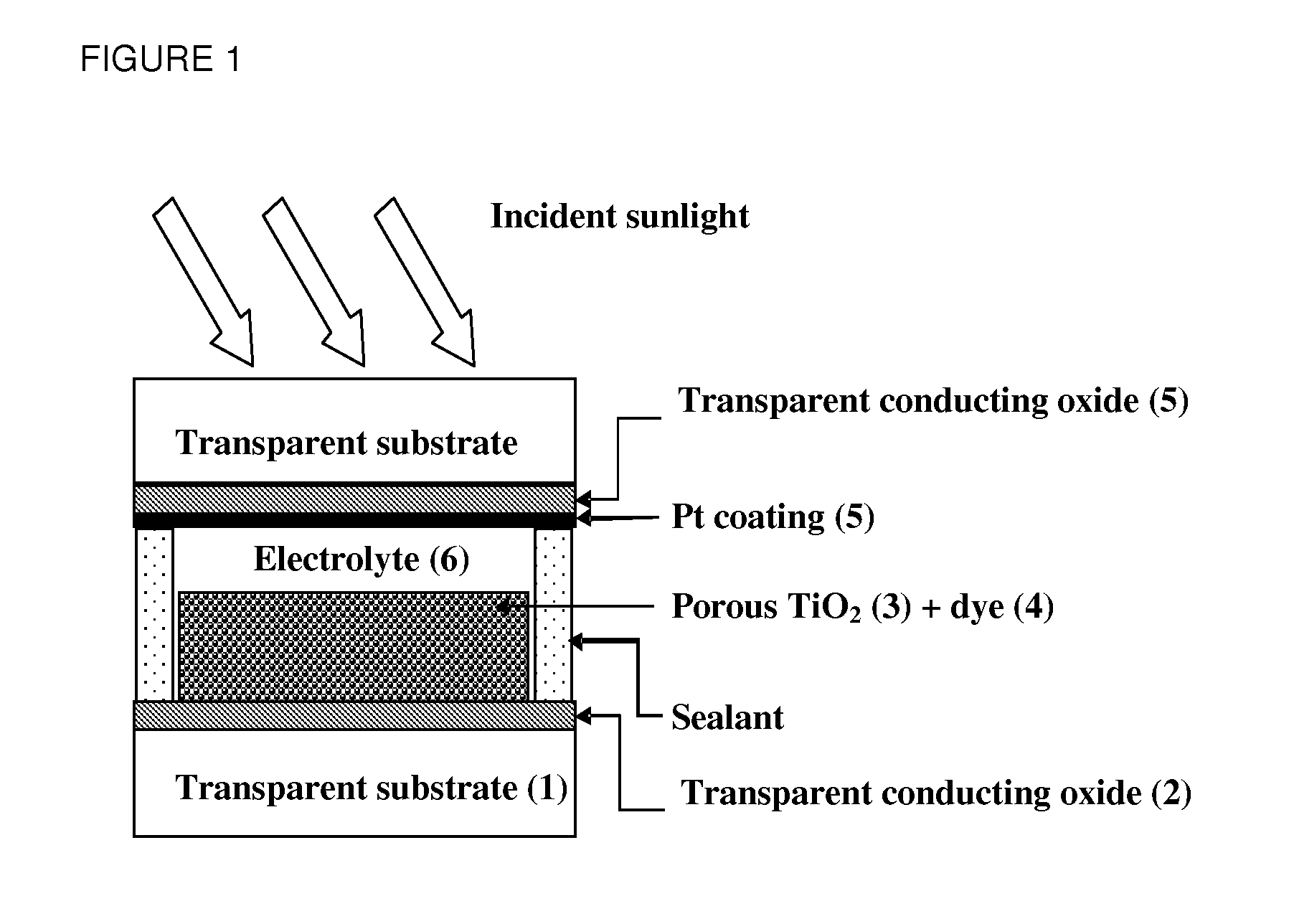Low temperature platinisation for dye-sensitised solar cells
a solar cell, low temperature technology, applied in the direction of electrolytic capacitors, liquid/solution decomposition chemical coatings, mechanical vibration separation, etc., can solve the problems of wasting energy that is merely transformed into heat, electrons also have a chance to recombine, cost in monetary price and also in embodied energy, and achieve the effect of reducing the temperature necessary
- Summary
- Abstract
- Description
- Claims
- Application Information
AI Technical Summary
Benefits of technology
Problems solved by technology
Method used
Image
Examples
example 1
[0090]Sandwich-type DSC cells devices were prepared following the structure described in FIG. 1. Commercial, screen printed titania working photoelectrodes (Dyesol Ltd, Australia) were heated to a temperature of 450° C. for a period of time of 30 minutes and then cooled down to a temperature of 100° C., ready for dyeing. The working electrodes were coated with fluorine tin oxide-coated glass with resistance of 15 Ω / cm2. The thin films of titania had a thickness of approximately 12 μm with a working area of 0.88 cm2.
[0091]The metal oxide films were dipped into ethanolic dye solution containing the di-ammonium salt of cis-bis(4,4′-dicarboxy-2,2′-bipyridine)dithiocyanato ruthenium(II), commonly known as N719 (1 mM) for time periods of 18-24 h. After dyeing, a thermoplastic polymer gasket (Surlyn® from Du Pont) was placed around the photoelectrode and a TCO-coated counter electrode which has been coated with platinum was placed on top and the electrodes sealed together at a temperature ...
example 2
[0093]In further examples according to the invention, sandwich-type DSC cells devices were prepared following the structure described in FIG. 1. Titania photo-electrodes were prepared by doctor blading two layers of a commercial titania paste (Dyesol Ltd, Australia) onto TEC glass with heating to a temperature of 450° C. for 30 minutes for each layer. In some examples, a layer of large scattering titania particles of the order of 400 nm was also added. Each titania layer was treated with TiCl4 solution and re-heated to 450° C. before a final cooling down to 100° C., ready for dyeing. The working electrodes were coated with fluorine tin oxide-coated glass with resistance of 15 Ω / cm2. The thin films of titania had a thickness of approximately 12 μm with a working area of 0.92-0.94 cm2.
[0094]The metal oxide films were dipped into ethanolic dye solution containing the di-ammonium salt of cis-bis(4,4′-dicarboxy-2,2′-bipyridine)dithiocyanato ruthenium(II), commonly known as N719 (1 mM) fo...
PUM
| Property | Measurement | Unit |
|---|---|---|
| temperature | aaaaa | aaaaa |
| temperature | aaaaa | aaaaa |
| voltage | aaaaa | aaaaa |
Abstract
Description
Claims
Application Information
 Login to View More
Login to View More - R&D
- Intellectual Property
- Life Sciences
- Materials
- Tech Scout
- Unparalleled Data Quality
- Higher Quality Content
- 60% Fewer Hallucinations
Browse by: Latest US Patents, China's latest patents, Technical Efficacy Thesaurus, Application Domain, Technology Topic, Popular Technical Reports.
© 2025 PatSnap. All rights reserved.Legal|Privacy policy|Modern Slavery Act Transparency Statement|Sitemap|About US| Contact US: help@patsnap.com


